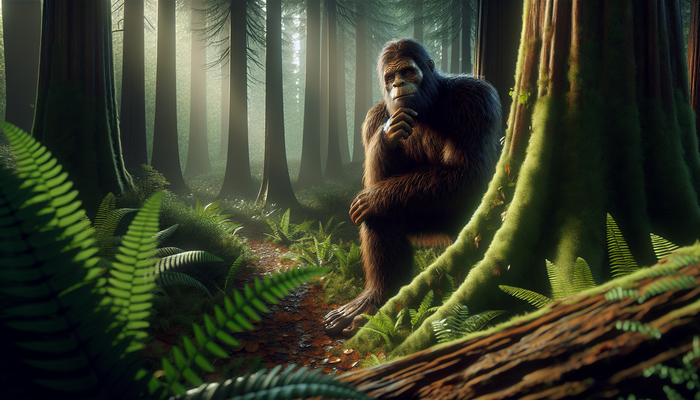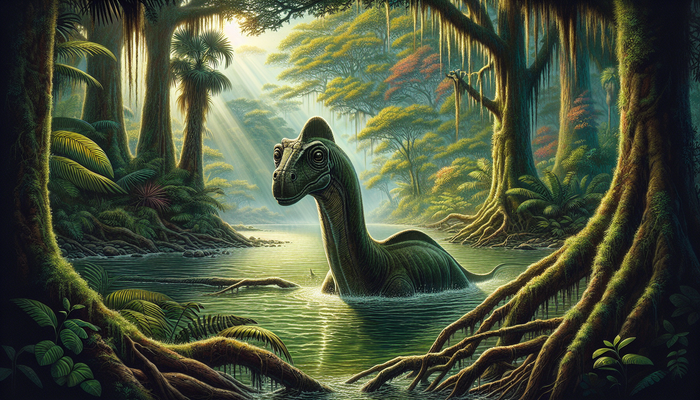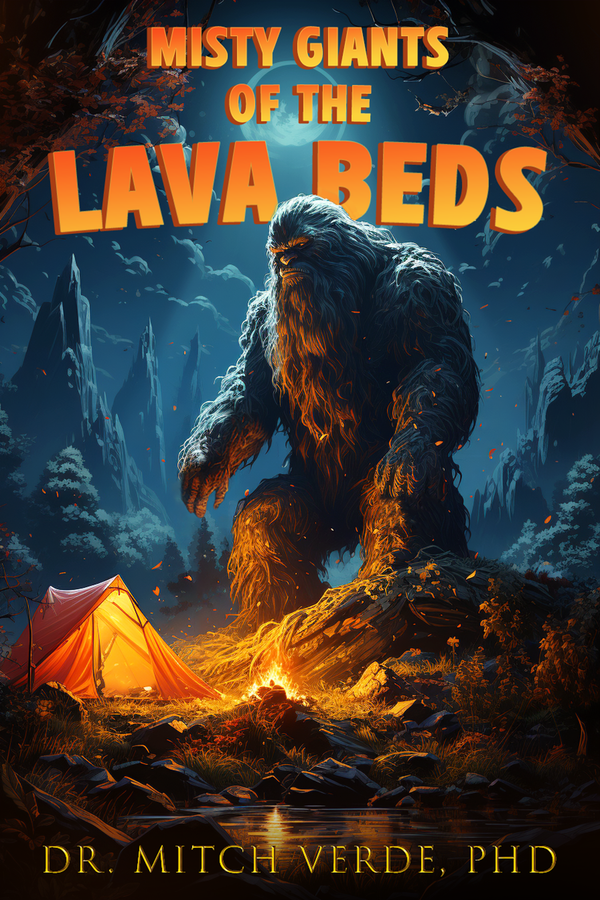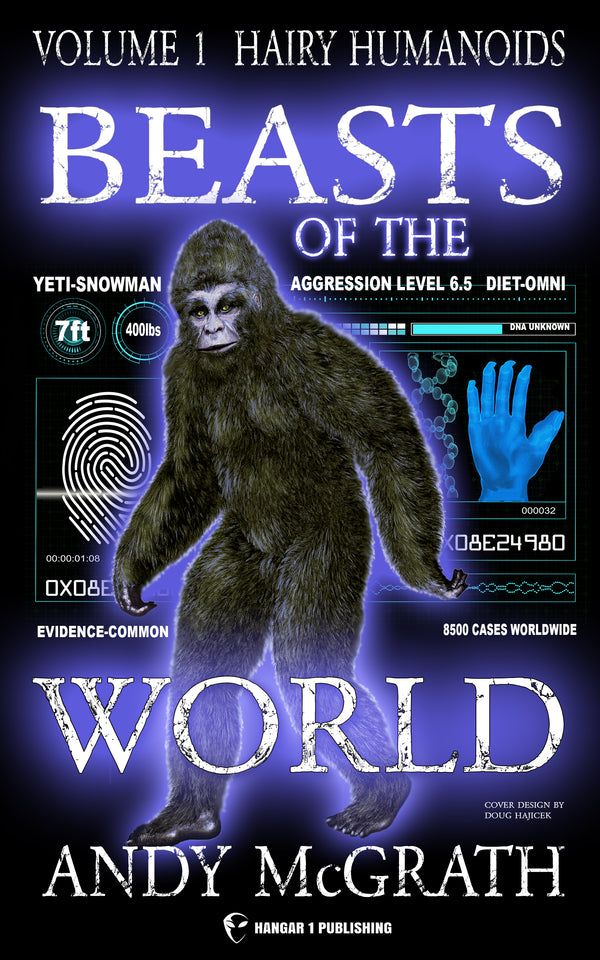Stalking the Shadows: California's Cryptids
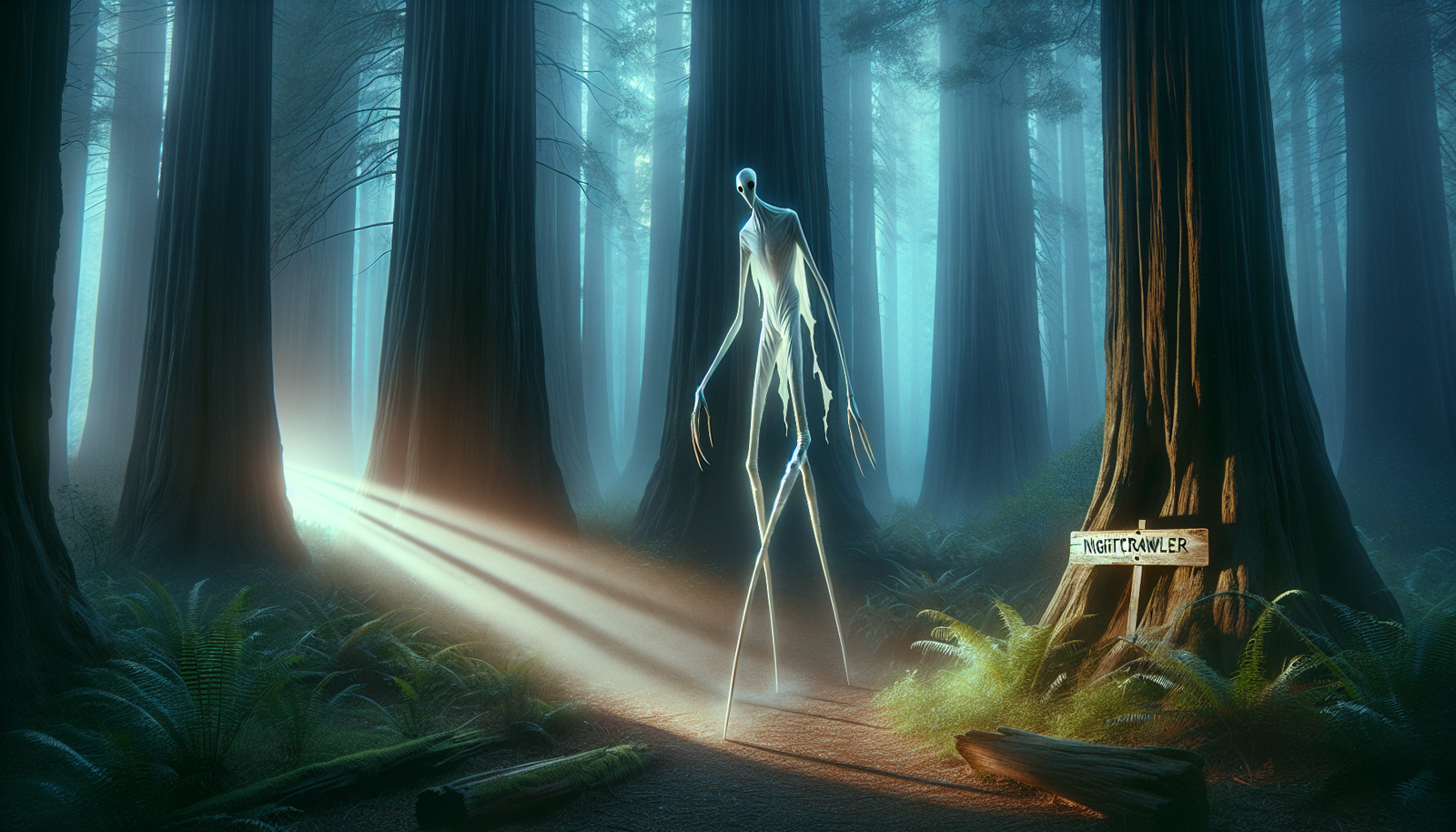
By Ava Martinez, Bigfoot Researcher and Teacher
In the realm of the unknown, where myth and reality intertwine, California stands as a land of endless intrigue. From its mist-shrouded forests to its scorching deserts, the Golden State has long been a haven for tales of mysterious creatures that lurk just beyond the edge of our understanding. These enigmatic entities, known as cryptids, have captured the imaginations of Californians for generations, weaving themselves into the very fabric of the state's rich folklore.
As a biology teacher and cryptozoology enthusiast, I've always been drawn to the allure of the unknown. Growing up in Northern California, I was immersed in stories of elusive creatures said to roam our vast wilderness. These tales ignited a curiosity in me that has evolved into a lifelong quest to unravel the mysteries surrounding California's cryptids.
California's diverse landscapes provide the perfect backdrop for cryptid encounters. From the dense redwood forests of the north to the sprawling deserts of the south, the state's varied terrain offers countless hiding places for these legendary beasts. It's no wonder that California boasts one of the richest histories of cryptid sightings and legends in the world.
In this article, we will embark on a journey through the shadows, exploring the mysterious menagerie of California cryptids. From the bizarre Fresno Nightcrawler to the elusive Bigfoot, we'll delve into the stories, sightings, and theories surrounding these enigmatic creatures. Along the way, we'll examine the cultural impact of these legends and the enduring human fascination with the unknown. So join me as we stalk the shadows and attempt to unravel the mysteries that have captivated Californians for generations.
The Fresno Nightcrawler: Enigmatic Entity or Elaborate Hoax?
In the annals of California cryptids, few are as peculiar as the Fresno Nightcrawler. This bizarre, bipedal creature first came to light in 2007, when a Fresno resident captured video footage of what appeared to be a pair of pale, spindly legs walking across his lawn in the dead of night. The creature, which seemed to lack any discernible upper body, moved with an eerie, almost otherworldly gait.
The grainy black and white security camera footage quickly went viral, sparking intense speculation about the nature of the creature. Some suggested that it could be an extraterrestrial being, pointing to its strange, almost insectoid appearance. Others proposed that it might be a previously unknown species, perhaps a type of walking stick insect or a mutated amphibian.
Skeptics, however, argued that the video was likely a hoax. They pointed out that the creature's movements seemed too fluid and purposeful to be those of a real animal. Some suggested that the Nightcrawler was nothing more than a pair of pants or leggings, manipulated by strings or rods to create the illusion of a walking creature.
Despite the debate, the Fresno Nightcrawler quickly captured the public's imagination. Subsequent sightings and video evidence emerged, fueling the legend of this enigmatic entity. In 2011, a similar creature was allegedly captured on a security camera in Yosemite National Park, leading some to speculate that the Nightcrawler might be more widespread than initially thought.
As the legend grew, so did the Nightcrawler's status as a pop culture icon. Artists and crafters began creating Nightcrawler-inspired merchandise, from t-shirts and stickers to plush toys and Halloween costumes. The city of Fresno even embraced its bizarre resident, hosting an annual "Nightcrawler Day" celebration complete with costume contests and themed events.
But what is the truth behind the Fresno Nightcrawler? Is it a genuine cryptid, an undiscovered species that has managed to evade scientific scrutiny? Or is it simply an elaborate hoax, a product of clever video editing and the human desire to believe in the extraordinary?
As a cryptozoology researcher, I've spent countless hours poring over the available evidence, attempting to separate fact from fiction. While I remain open to the possibility of the Nightcrawler's existence, I also recognize the need for healthy skepticism. Until more concrete evidence emerges, the true nature of this enigmatic entity will likely remain a mystery.
The Dark Watchers: Sentinels of the Santa Lucia Mountains
High in the rugged peaks of the Santa Lucia Mountains, a range that stretches along California's central coast, a different kind of cryptid is said to keep watch over the wilderness. The Dark Watchers, as they have come to be known, are tall, shadowy figures that stand silently on the ridges and cliffs, observing the world below with an inscrutable gaze.
The legend of the Dark Watchers is deeply rooted in California history, with accounts dating back centuries. Native American tribes in the region, such as the Chumash and Esselen, have long told stories of these mysterious sentinels. According to their legends, the Watchers are the spirits of ancient warriors or shamans, tasked with guarding the land and its secrets.
Spanish settlers in the 1700s also documented encounters with the Dark Watchers. They described them as tall, humanoid figures draped in dark cloaks and wide-brimmed hats, standing motionless on the mountain peaks. The settlers dubbed them "Los Vigilantes Oscuros," or "The Dark Watchers," a name that has stuck to this day.
Over the years, countless hikers, campers, and residents of the Santa Lucia Mountains have reported sightings of the Dark Watchers. They are typically described as being between 7 and 15 feet tall, with featureless faces and an aura of silent, watchful intensity. Some witnesses claim to have felt an overwhelming sense of dread or unease in their presence, as if the Watchers were passing judgment on those who dared to enter their domain.
Despite the numerous sightings, the true nature of the Dark Watchers remains a mystery. Some believe they are supernatural entities, the ghosts of long-dead warriors or the manifestations of some ancient, unknowable force. Others suggest that they may be interdimensional beings, visitors from another realm who have taken an interest in our world.
There are also those who propose more mundane explanations for the Dark Watchers. Some argue that they are simply optical illusions, created by the play of light and shadow on the rugged mountain terrain. Others suggest that they may be misidentified wildlife, such as bears or mountain lions, their silhouettes distorted by distance and the observer's imagination.
The Dark Watchers have captured the imaginations of writers and artists for generations. John Steinbeck, in his short story "Flight," described them as "dark forms against the sky," looming over the mountains like silent guardians. Robinson Jeffers, in his poem "Such Counsels You Gave To Me," wrote of "the watchers, who are often seen in this length of coast-range, forms that look human to human eyes, but certainly are not human."
As a cryptozoology enthusiast, I find the legend of the Dark Watchers to be one of the most compelling and enigmatic in California folklore. The consistency of the sightings, the ancient Native American legends, and the sheer eeriness of these silent sentinels all contribute to the enduring mystery surrounding them.
While I have never personally encountered a Dark Watcher, I have spent countless hours hiking the trails of the Santa Lucia Mountains, always keeping a watchful eye on the ridges above. There is something undeniably haunting about these peaks, a sense of ancient mystery that seems to permeate the very air. Whether the Dark Watchers are real or simply a product of our collective imagination, they serve as a reminder of the untamed wildness that still exists in California's wilderness.
Bigfoot: The Elusive Man-Ape of Northern California
No discussion of California cryptids would be complete without mentioning the most famous of them all: Bigfoot. This elusive man-ape has been a staple of Northern California folklore for centuries, with sightings and legends dating back to the early days of European settlement in the region.
The modern legend of Bigfoot can be traced back to 1958, when a series of large, humanoid footprints were discovered in the forests near Bluff Creek, California. The tracks, which measured up to 16 inches in length, were unlike anything the local residents had ever seen before. News of the discovery quickly spread, and the creature responsible for the prints was dubbed "Bigfoot" by the media.
But the Bigfoot legend truly exploded into the public consciousness in 1967, with the release of the now-infamous Patterson-Gimlin film. The grainy, shaky footage, captured by Roger Patterson and Bob Gimlin in the forests of Northern California, purported to show a large, hairy, bipedal creature striding through a clearing. Despite decades of analysis and debate, the film remains the most compelling piece of evidence for the existence of Bigfoot.
Native American tribes in the region have long told stories of Bigfoot-like creatures. The Lummi people of the Pacific Northwest speak of "Ts'emekwes," a hairy, man-like beast that roams the forests, while the Yokuts of central California have legends of "Mayak Datat," a similar creature said to inhabit the Sierra Nevada mountains. These ancient stories suggest that the Bigfoot legend may have roots that stretch back long before European settlers arrived in the region.
Today, the town of Willow Creek, located in the heart of Northern California's "Bigfoot Country," has become a mecca for Bigfoot enthusiasts. The town is home to the annual "Bigfoot Daze" festival, which attracts thousands of visitors each year. The festival features Bigfoot-themed events, including a Bigfoot calling contest, a Bigfoot footprint casting workshop, and even a Bigfoot beauty pageant.
But what is the truth behind the Bigfoot legend? Is there really an undiscovered primate species lurking in the forests of Northern California, or is Bigfoot simply a product of folklore and misidentification?
As a cryptozoology researcher, I have spent years investigating the Bigfoot phenomenon. I have interviewed dozens of eyewitnesses, analyzed countless pieces of evidence, and even conducted my own field expeditions in search of the elusive creature. While I have yet to encounter Bigfoot myself, I remain open to the possibility of its existence.
There are several compelling theories about the nature of Bigfoot. Some researchers believe that it may be a relict population of Gigantopithecus, a giant ape that went extinct hundreds of thousands of years ago. Others suggest that Bigfoot could be a previously unknown species of primate, perhaps a descendant of the extinct Meganthropus. There are even those who propose that Bigfoot may be a species of prehistoric human, such as Homo erectus or Neanderthal, that has managed to survive in the remote wilderness of North America.
Of course, there are also plenty of skeptics who argue that Bigfoot is nothing more than a myth. They point to the lack of physical evidence, such as bodies or bones, and suggest that most Bigfoot sightings can be attributed to misidentification of known animals, such as bears or even humans. Some even go so far as to claim that the entire Bigfoot phenomenon is a hoax, perpetuated by attention-seekers and pranksters.
As with many cryptids, the truth about Bigfoot likely lies somewhere in between these extremes. While I believe that there is compelling evidence to suggest that something unusual is lurking in the forests of Northern California, I also recognize the need for rigorous scientific inquiry and skepticism. Until definitive proof of Bigfoot's existence is found, the legend will likely continue to captivate the imaginations of Californians and cryptozoology enthusiasts around the world.
Lake Monsters: Lurking in the Depths
California's lakes and waterways are home to a diverse array of aquatic life, from trout and bass to otters and beavers. But according to local legends, these bodies of water may also be hiding something far more mysterious and elusive: lake monsters.
One of the most famous of these aquatic cryptids is Tahoe Tessie, the friendly serpent said to inhabit the depths of Lake Tahoe. Sightings of Tessie date back to the mid-19th century, when the Washoe and Paiute tribes first began telling stories of a large, serpentine creature that lurked beneath the surface of the lake.
Modern sightings of Tessie describe a creature that is anywhere from 10 to 80 feet in length, with a slender, snake-like body and a head that resembles that of a camel or a horse. Some witnesses claim to have seen Tessie swimming alongside boats or even breaching the surface of the water like a whale.
Despite her fearsome appearance, Tessie is generally regarded as a benevolent creature. Unlike many lake monsters, which are often associated with death and destruction, Tessie is seen as a friendly guardian of Lake Tahoe. In fact, she has become something of a local mascot, with her image gracing everything from t-shirts and postcards to murals and public art installations.
So what could Tessie be? Some researchers believe that she may be a surviving plesiosaur, a type of marine reptile that went extinct millions of years ago. Others suggest that she could be a giant sturgeon or eel, species that are known to inhabit the depths of Lake Tahoe. There are even those who propose that Tessie may be a previously unknown species of freshwater serpent or dragon.
While Tahoe Tessie is generally regarded as a friendly presence, not all of California's lake monsters are so benevolent. In the remote reaches of Los Angeles County, there is a body of water known as Lake Elizabeth that is said to be home to a far more sinister creature.
According to local legend, Lake Elizabeth was created by the devil himself, who placed one of his own pets in the water to guard the entrance to hell. This creature, known as the Devil's Pet, is said to be a terrifying amalgamation of bat, whale, and sea serpent, with a body as large as a house and eyes that glow red in the darkness.
Sightings of the Devil's Pet date back to the 19th century, when settlers first began to arrive in the area. One of the earliest accounts comes from 1886, when a group of hunters claimed to have seen a "water dragon" emerge from the depths of the lake and attack their camp. The creature was described as having a long, serpentine body, bat-like wings, and a head that resembled that of a demon.
Since then, there have been sporadic sightings of the Devil's Pet, often accompanied by reports of strange noises and eerie lights emanating from the lake. Some witnesses claim to have seen the creature flying over the water at night, its wings silhouetted against the moon. Others have reported feeling a sense of dread or unease when near the lake, as if some malevolent presence were watching them from the depths.
As a cryptozoology researcher, I find the legends surrounding California's lake monsters to be some of the most fascinating and enduring in the state's folklore. While it is easy to dismiss these stories as mere myths or tall tales, there is something undeniably compelling about the idea of ancient, unknown creatures lurking beneath the surface of our lakes and waterways.
From Bigfoot to UFOs: Hangar 1 Publishing Has You Covered!
Explore Untold Stories: Venture into the world of UFOs, cryptids, Bigfoot, and beyond. Every story is a journey into the extraordinary.
Immersive Book Technology: Experience real videos, sights, and sounds within our books. Its not just reading; its an adventure.




